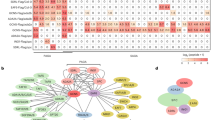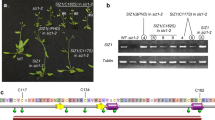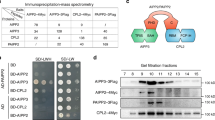Abstract
Key message
Overexpression of ABI5/ABF binding proteins (AFPs) results in extreme ABA resistance of seeds via multiple mechanisms repressing ABA response, including interactions with histone deacetylases and the co-repressor TOPLESS.
Abstract
Several ABI5/ABF binding proteins (AFPs) inhibit ABA response, resulting in extreme ABA resistance in transgenic Arabidopsis overexpression lines, but their mechanism of action has remained obscure. By analogy to the related Novel Interactor of JAZ (NINJA) protein, it was suggested that the AFPs interact with the co-repressor TOPLESS to inhibit ABA-regulated gene expression. This study shows that the AFPs that inhibit ABA response have intrinsic repressor activity in a heterologous system, which does not depend on the domain involved in the interaction with TOPLESS. This domain is also not essential for repressing ABA response in transgenic plants, but does contribute to stronger ABA resistance. Additional interactions between some AFPs and histone deacetylase subunits were observed in yeast two-hybrid and bimolecular fluorescence assays, consistent with a more direct mechanism of AFP-mediated repression of gene expression. Chemical inhibition of histone deacetylase activity by trichostatin A suppressed AFP effects on a small fraction of the ABI5-regulated genes tested. Collectively, these results suggest that the AFPs participate in multiple mechanisms modulating ABA response, including both TOPLESS-dependent and -independent chromatin modification.










Similar content being viewed by others
Abbreviations
- ABA:
-
Abscisic acid
- ABI:
-
ABA-insensitive
- AFP:
-
ABI five binding protein
- ABF/AREB:
-
ABRE binding factor
- ABRE:
-
ABA-responsive element
- AD:
-
GAL4 activation domain
- Em6:
-
Arabidopsis early methionine-labelled 6
- BiFC:
-
Bimolecular fluorescence complementation
- BD:
-
GAL4 binding domain
- bZIP:
-
Basic leucine zipper
- EAR domain:
-
Ethylene-responsive element binding factor-associated amphiphilic repression domain
- GM:
-
Germination media
- HDA or HDAC:
-
Histone deacetylase
- Lea:
-
Late embryogenesis abundant
- Min:
-
Minimal media
- MODD:
-
Mediator of OsbZIP46 deactivation and degradation
- NINJA:
-
Novel Interactor of JAZ
- RAB18:
-
Responsive to ABA 18
- SAP18:
-
Sin3-associated protein 18
- TPL/TPR:
-
Topless and topless-related
- TSA:
-
Trichostatin A
References
Bassel GW, Fung P, Chow T-fF, Foong JA, Provart NJ, Cutler SR (2008) Elucidating the germination transcriptional program using small molecules. Plant Physiol 147:143–155
Bouyer D, Roudier F, Heese M, Andersen ED, Gey D, Nowack MK, Goodrich J, Renou J-P, Grini PE, Colot V (2009) Polycomb repressive complex 2 controls the embryo-to-seedling phase transition. PLoS Genet 7:e1002014
Carr AC, Moore SD (2012) Robust quantification of polymerase chain reactions using global fitting. PLoS ONE 7:e37640
Causier B, Ashworth M, Guo W, Davies B (2012) The TOPLESS interactome: a framework for gene repression in Arabidopsis. Plant Physiol 158:423–438
Clough S, Bent A (1998) Floral dip: a simplified method for Agrobacterium-mediated transformation of Arabidopsis thaliana. Plant J 16:735–743
Czechowski T, Stitt M, Altmann T, Udvardi MK, Scheible W-R (2005) Genome-wide identification and testing of superior reference genes for transcript normalization in Arabidopsis. Plant Physiol 139:5–17
Dosztanyi Z, Meszaros B, Simon I (2009) ANCHOR: web server for predicting protein binding regions in disordered proteins. Bioinformatics 25:2745–2746
Earley K, Haag J, Pontes O, Opper K, Juehne T, Song K, Pikaard C (2006) Gateway-compatible vectors for plant functional genomics and proteomics. Plant J 45:616–629
Finkelstein R (2013) Abscisic acid synthesis and response. Arabidopsis Book 11:e0166
Finkelstein R, Lynch T (2000) The Arabidopsis abscisic acid response gene ABI5 encodes a basic leucine zipper transcription factor. Plant Cell 12:599–609
Finkelstein R, Gampala SSL, Lynch TJ, Thomas TL, Rock CD (2005) Redundant and distinct functions of the ABA response loci ABA-INSENSITIVE(ABI)5 and ABRE-BINDING FACTOR (ABF)3. Plant Mol Biol 59:253–267
Finkelstein R, Reeves W, Ariizumi T, Steber C (2008) Molecular aspects of seed dormancy. Ann Rev Plant Biol 59:387–415
Footitt S, Müller K, Kermode AR, Finch-Savage WE (2015) Seed dormancy cycling in Arabidopsis: chromatin remodelling and regulation of DOG1 in response to seasonal environmental signals. Plant J 81:413–425
Fu C, Wehr DR, Edwards J, Hauge B (2008) Rapid one-step recombinational cloning. Nucleic Acids Res 36:e54–e54
Garcia M, Lynch T, Peeters J, Snowden C, Finkelstein R (2008) A small plant-specific protein family of ABI five binding proteins (AFPs) regulates stress response in germinating Arabidopsis seeds and seedlings. Plant Mol Biol 67:643–658
Han S-K, Sang Y, Rodrigues A, F2010 B, Wu M-F, Rodriguez PL, Wagner D (2012) The SWI2/SNF2 chromatin remodeling ATPase BRAHMA represses abscisic acid responses in the absence of the stress stimulus in Arabidopsis. Plant Cell 24:4892–4906
Haughn G, Somerville C (1986) Sulfonylurea-resistant mutants of Arabidopsis thaliana. Mol Gen Genet 204:430–434
Huang MD, Wu WL (2007) Overexpression of TMAC2, a novel negative regulator of abscisic acid and salinity responses, has pleiotropic effects in Arabidopsis thaliana. Plant Mol Biol 63:557–569
James P, Halladay J, Craig E (1996) Genomic libraries and a host strain designed for highly efficient two-hybrid selection in yeast. Genetics 144:1425–1436
Kagale S, Rozwadowski K (2011) EAR motif-mediated transcriptional repression in plants: an underlying mechanism for epigenetic regulation of gene expression. Epigenetics 6:141–146
Ke J, Ma H, Gu X, Thelen A, Brunzelle JS, Li J, Xu HE, Melcher K (2015) Structural basis for recognition of diverse transcriptional repressors by the TOPLESS family of corepressors. Sci Adv 1:e1500107
Korasick DA, Westfall CS, Lee SG, Nanao MH, Dumas R, Hagen G, Guilfoyle TJ, Jez JM, Strader LC (2014) Molecular basis for AUXIN RESPONSE FACTOR protein interaction and the control of auxin response repression. Proc Natl Acad Sci USA 111:5427–5432
Laemmli UK (1970) Cleavage of structural proteins during the assembly of the head of bacteriophage T4. Nature 227:680–685
Liu X, Yang S, Zhao M, Luo M, Yu C-W, Chen C-Y, Tai R, Wu K (2014) Transcriptional repression by histone deacetylases in plants. Mol Plant 7:764–772
Lopez-Molina L, Mongrand S, Chua N-H (2001) A postgermination developmental arrest checkpoint is mediated by abscisic acid and requires the ABI5 transcription factor in Arabidopsis. Proc Natl Acad Sci USA 98:4782–4787
Lopez-Molina L, Mongrand S, Kinoshita N, Chua N-H (2003) AFP is a novel negative regulator of ABA signaling that promotes ABI5 protein degradation. Genes Dev 17:410–418
Lumba S, Toh S, Handfield L-F, Swan M, Liu R, Youn J-Y, Cutler SR, Subramaniam R, Provart N, Moses A, Desveaux D, McCourt P (2014) A mesoscale abscisic acid hormone interactome reveals a dynamic signaling landscape in Arabidopsis. Dev Cell 29:360–372
Murashige T, Skoog F (1962) A revised medium for rapid growth and bioassays with tobacco tissue cultures. Physiol Plant 15:473–497
Nakabayashi K, Okamoto M, Koshiba T, Kamiya Y, Nambara E (2005) Genome-wide profiling of stored mRNA in Arabidopsis thaliana seed germination: epigenetic and genetic regulation of transcription in seed. Plant J 41:697–709
Pauwels L, Barbero GF, Geerinck J, Tilleman S, Grunewald W, Perez AC, Chico JM, Bossche RV, Sewell J, Gil E, Garcia-Casado G, Witters E, Inze D, Long JA, De Jaeger G, Solano R, Goossens A (2010) NINJA connects the co-repressor TOPLESS to jasmonate signalling. Nature 464:788–791
Pietrosemoli N, García-Martín J, Solano R, Pazos F (2013) Genome-wide analysis of protein disorder in Arabidopsis thaliana: implications for plant environmental adaptation. PLoS ONE 8:e55524
Reeves W, Lynch T, Mobin R, Finkelstein R (2011) Direct targets of the transcription factors ABA-Insensitive(ABI)4 and ABI5 reveal synergistic action by ABI4 and several bZIP ABA response factors. Plant Mol Biol 75:347–363
Ryu H, Cho H, Bae W, Hwang I (2014) Control of early seedling development by BES1/TPL/HDA19-mediated epigenetic regulation of ABI3. Nat Commun 5:4138
Saha S, Brickman JM, Lehming N, Ptashne M (1993) New eukaryotic transcriptional repressers. Nature 363:648–652
Schindelin J, Arganda-Carreras I, Frise E, Kaynig V, Longair M, Pietzsch T, Preibisch S, Rueden C, Saalfeld S, Schmid B, Tinevez J-Y, White DJ, Hartenstein V, Eliceiri K, Tomancak P, Cardona A (2012) Fiji: an open-source platform for biological-image analysis. Nat Methods 9:676–682
Schneider A, Aghamirzaie D, Elmarakeby H, Poudel AN, Koo AJ, Heath LS, Grene R, Collakova E (2016) Potential targets of VIVIPAROUS1/ABI3-LIKE1 (VAL1) repression in developing Arabidopsis thaliana embryos. Plant J 85:305–319
Sun X, Rikkerink EHA, Jones WT, Uversky VN (2013) Multifarious roles of intrinsic disorder in proteins illustrate its broad impact on plant biology. Plant Cell 25:38–55
Tai HH, Tai GCC, Beardmore T (2005) Dynamic histone acetylation of late embryonic genes during seed germination. Plant Mol Biol 59:909–925
Tanaka M, Kikuchi A, Kamada H (2008) The Arabidopsis histone deacetylases HDA6 and HDA19 contribute to the repression of embryonic properties after germination. Plant Physiol 146:149–161
Tang N, Ma S, Zong W, Yang N, Lv Y, Yan C, Guo Z, Li J, Li X, Xiang Y, Song H, Xiao J, Li X, Xiong L (2016) MODD mediates deactivation and degradation of OsbZIP46 to negatively regulate aba signaling and drought resistance in rice. Plant Cell 28:2161–2177
Toufighi K, Brady SM, Austin R, Ly E, Provart NJ (2005) The Botany Array Resource: e-Northerns, expression angling, and promoter analyses. Plant J 43:153–163
Turoverov KK, Kuznetsova IM, Uversky VN (2010) The protein kingdom extended: Ordered and intrinsically disordered proteins, their folding, supramolecular complex formation, and aggregation. Prog Biophys Mol Biol 102:73–84
van Zanten M, Liu Y, Soppe WJJ (2013) Epigenetic signalling during the life of seeds. In: Grafi G, Ohad N (eds) Epigenetic memory and control in plants. Springer, New York, pp 127–153
van Zanten M, Zöll C, Wang Z, Philipp C, Carles A, Li Y, Kornet NG, Liu Y, Soppe WJJ (2014) HISTONE DEACETYLASE 9 represses seedling traits in Arabidopsis thaliana dry seeds. Plant J 80:475–488
Veerappan V, Wang J, Kang M, Lee J, Tang Y, Jha AK, Shi H, Palanivelu R, Allen RD (2012) A novel HSI2 mutation in Arabidopsis affects the PHD-like domain and leads to derepression of seed-specific gene expression. Planta 236:1–17
Voinnet O, Rivas S, Mestre P, Baulcombe D (2003) An enhanced transient expression system in plants based on suppression of gene silencing by the p19 protein of tomato bushy stunt virus. Plant J 33:949–956
Wang Z, Chen F, Li X, Cao H, Ding M, Zhang C, Zuo J, Xu C, Xu J, Deng X, Xiang Y, Soppe WJJ, Liu Y (2016) Arabidopsis seed germination speed is controlled by SNL histone deacetylase-binding factor-mediated regulation of AUX1. Nat Comm 7: 13412
Winter D, Vinegar B, Nahal H, Ammar R, Wilson GV, Provart NJ (2007) An “electronic fluorescent pictograph” browser for exploring and analyzing large-scale biological data sets. PLoS ONE 2:e718
Yamada K, Lim J, Dale JM, Chen H, Shinn P, Palm CJ, Southwick AM, Wu HC, Kim C, Nguyen M et al (2003) Empirical analysis of the transcriptional activity in the Arabidopsis genome. Science 302:842–846
Yoshida T, Fujita Y, Sayama H, Kidokoro S, Maruyama K, Mizoi J, Shinozaki K, Yamaguchi-Shinozaki K (2010) AREB1, AREB2, and ABF3 are master transcription factors that cooperatively regulate ABRE-dependent ABA signaling involved in drought stress tolerance and require ABA for full activation. Plant J 61:672–685
Zhang H, Ogas J (2009) An epigenetic perspective on developmental regulation of seed genes. Mol Plant 2:610–627
Acknowledgements
We thank the ABRC team at Ohio State University for efficient distribution of vectors and cDNA clones, Dr. Xinnian Dong for the yeast cell line Y122, Dr. Barry Causier for the TPL and TPR cDNAs, and Adam Protter for assistance in constructing the YFP-AFP3 fusion. This work was supported by UCSB Academic Senate Grant to RRF, Faculty Research Assistance Program funds, and National Science Foundation Grant# IOS1558011 to RRF.
Author contributions
RRF conceived and performed experiments, wrote the manuscript, and repeatedly applied for funding. TJL conceived and performed experiments and provided feedback. BJE and DRM performed experiments and provided feedback.
Author information
Authors and Affiliations
Corresponding author
Electronic supplementary material
Below is the link to the electronic supplementary material.
Rights and permissions
About this article
Cite this article
Lynch, T.J., Erickson, B.J., Miller, D.R. et al. ABI5-binding proteins (AFPs) alter transcription of ABA-induced genes via a variety of interactions with chromatin modifiers. Plant Mol Biol 93, 403–418 (2017). https://doi.org/10.1007/s11103-016-0569-1
Received:
Accepted:
Published:
Issue Date:
DOI: https://doi.org/10.1007/s11103-016-0569-1




